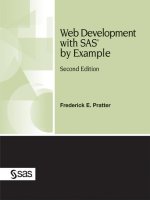Prentice hall UNIX shells by example 3rd edition oct 2001 ISBN 013066538x
Bạn đang xem bản rút gọn của tài liệu. Xem và tải ngay bản đầy đủ của tài liệu tại đây (8.26 MB, 1,995 trang )
UNIX®ShellsbyExample,ThirdEdition
ByEllieQuigley
Publisher :PrenticeHallPTR
PubDate :October01,2001
ISBN :0-13-066538-X
Pages :1040
FiveUNIXshells,threeessentialutilities,one
indispensableresource!
LearnUNIXshellprogrammingtheeasyway,
usinghands-onexamples
CoversallfiveleadingUNIXshells-C,Bourne,
Korn,bash,andtcsh
Bybest-sellingauthorEllieQuigley,Silicon
Valley'stopUNIXinstructor
Thebest-sellingUNIXShellsbyExamplecontinues
tobetheonlybookyouneedtolearnUNIXshell
programming.UNIXShellsbyExample,Third
Editionaddsthoroughcoverageofthenewbashand
tcshshellstothefullexplanationsinQuigley's
famoustreatmentoftheC,Bourne,andKornshells
andtheawk,sed,andgreputilities,makingthisthe
mostcompleteUNIXshellprogrammingbook
Tableof availableanywhere.Usingproventechniquesdrawn
•
Contents fromheracclaimedSiliconValleyUNIXclasses,
• Examples Quigleytransformsyouintoanexpert-levelshell
programmer.You'lllearnwhattheshellsare,what
theydo,andhowtoprogramthem,aswellashow
andwhentouseawk,sed,andgrep.Code
examples,completelyrevisedandclassroom-tested
forthisedition,explainconceptsfirst-handandcan
serveasthebasisforyourownprojects.
ExplainstheC,Bourne,Korn,bash,andtcshshells
inonecohesiveway-you'llunderstandwhichshellto
useandwhyDetailstheessentialawk,sed,and
grepprogrammingutilitiesOffersproventeaching
methodsfromatopUNIXshellinstructorProvides
sourcecodeanddatafilesforallexamplesonthe
CD-ROM,soyoucanexperimentwiththemonyour
ownsystemUNIXsystemadministrators,application
developers,andpoweruserswillturntothisbook
againandagain,bothasavitalclassroomlearning
toolandasafavoritereferencemanual.
777
Copyright
Preface
ACKNOWLEDGMENTS
Chapter1.IntroductiontoUNIXShells
Section1.1.DefinitionandFunction
Section1.2.SystemStartupandtheLoginShell
Section1.3.ProcessesandtheShell
Section1.4.TheEnvironmentandInheritance
Section1.5.ExecutingCommandsfromScripts
Chapter2.TheUNIXToolbox
Section2.1.RegularExpressions
Section2.2.CombiningRegularExpressionMetacharacters
Chapter3.ThegrepFamily
Section3.1.ThegrepCommand
Section3.2.grepExampleswithRegularExpressions
Section3.3.grepwithPipes
Section3.4.grepwithOptions
Section3.5.egrep(Extendedgrep)
Section3.6.FixedgreporFastgrep
UNIXTOOLSLABEXERCISE
Chapter4.sed,theStreamlinedEditor
Section4.1.WhatIssed?
Section4.2.HowDoessedWork?
Section4.3.Addressing
Section4.4.CommandsandOptions
Section4.5.ErrorMessagesandExitStatus
Section4.6.sedExamples
Section4.7.sedScripting
UNIXTOOLSLABEXERCISE
Chapter5.TheawkUtility:awkasaUNIXTool
Section5.1.WhatIsawk?
Section5.2.awk'sFormat
Section5.3.FormattingOutput
Section5.4.awkCommandsfromWithinaFile
Section5.5.RecordsandFields
Section5.6.PatternsandActions
Section5.7.RegularExpressions
Section5.8.awkCommandsinaScriptFile
Section5.9.Review
UNIXTOOLSLABEXERCISE
Chapter6.TheawkUtility:awkProgrammingConstructs
Section6.1.ComparisonExpressions
Section6.2.Review
UNIXTOOLSLABEXERCISE
Chapter7.TheawkUtility:awkProgramming
Section7.1.Variables
Section7.2.RedirectionandPipes
Section7.3.Pipes
Section7.4.ClosingFilesandPipes
Section7.5.Review
UNIXTOOLSLABEXERCISE
Section7.6.ConditionalStatements
Section7.7.Loops
Section7.8.ProgramControlStatements
Section7.9.Arrays
Section7.10.awkBuilt-InFunctions
Section7.11.Built-InArithmeticFunctions
Section7.12.User-DefinedFunctions(nawk)
Section7.13.Review
UNIXTOOLSLABEXERCISE
Section7.14.OddsandEnds
Section7.15.Review
UNIXTOOLSLABEXERCISE
Chapter8.TheInteractiveBourneShell
Section8.1.Startup
Section8.2.ProgrammingwiththeBourneShell
BOURNESHELLLABEXERCISES
Chapter9.TheCShell
Section9.1.TheInteractiveCShell
Section9.2.ProgrammingwiththeCShell
CSHELLLABEXERCISES
Chapter10.TheKornShell
Section10.1.InteractiveKornShell
Section10.2.ProgrammingwiththeKornShell
KORNSHELLLABEXERCISES
Chapter11.TheInteractivebashShell
Section11.1.Introduction
Section11.2.CommandLineShortcuts
Section11.3.Variables
BASHSHELLLABEXERCISES
Chapter12.ProgrammingwiththebashShell
Section12.1.Introduction
Section12.2.ReadingUserInput
Section12.3.Arithmetic
Section12.4.PositionalParametersandCommandLineArguments
Section12.5.ConditionalConstructsandFlowControl
Section12.6.LoopingCommands
Section12.7.Functions
Section12.8.TrappingSignals
Section12.9.Debugging
Section12.10.ProcessingCommandLineOptionswithgetopts
Section12.11.TheevalCommandandParsingtheCommandLine
Section12.12.bashOptions
Section12.13.ShellBuilt-InCommands
BASHSHELLLABEXERCISES
Chapter13.TheInteractiveTCShell
Section13.1.Introduction
Section13.2.TheTCShellEnvironment
Section13.3.CommandLineShortcuts
Section13.4.JobControl
Section13.5.Metacharacters
Section13.6.RedirectionandPipes
Section13.7.Variables
Section13.8.Arrays
Section13.9.SpecialVariablesandModifiers
Section13.10.CommandSubstitution
Section13.11.Quoting
Section13.12.Built-InCommands
TCSHELLLABEXERCISES
AppendixA.UsefulUNIXUtilitiesforShellProgrammers
at—at,batch—executecommandsatalatertime
awk—patternscanningandprocessinglanguage
banner—makeposters
basename—withadirectorynamedeliversportionsofthepathname
bc—processesprecisionarithmetic
bdiff—comparestwobigfiles
cal—displaysacalendar
cat—concatenatesanddisplaysfiles
chmod—changethepermissionsmodeofafile
chown—changesowneroffile
clear—clearstheterminalscreen
cmp—comparestwofiles
compress—compress,uncompress,zcatcompress,uncompressfiles,ordisplay
expandedfiles
cp—copiesfiles
cpio—copyfilearchivesinandout
cron—theclockdaemon
crypt—encodesordecodesafile
cut—removesselectedfieldsorcharactersfromeachlineofafile
date—displaysthedateandtimeorsetsthedate
diff—comparestwofilesfordifferencesdiff[–bitw][–c|–Cn
du—summarizesdiskusage
echo—echoesarguments
egrep—searchesafileforapatternusingfullregularexpressions
expr—evaluatesargumentsasanexpression
fgrep—searchafileforacharacterstring
file—determinesthetypeofafilebylookingatitscontents
find—findsfiles
finger—displaysinformationaboutlocalandremoteusers
fmt—simpletextformatters
fold—foldslonglines
ftp—filetransferprogram
getopt(s)—parsescommandlineoptions
grep—searchesafileforapattern
groups—printsgroupmembershipofuser
id—printstheusername,userID,groupnameandgroupID
jsh—thestandard,jobcontrolshell
line—readsoneline
logname—getsthenameoftheuserrunningtheprocess
lp—sendsoutputtoaprinter(AT&T)
lpr—sendsoutputtoaprinter(UCB)
lpstat—printinformationaboutthestatusoftheLPprintservice(AT&T)
lpq—printinformationaboutthestatusoftheprinter(UCB)
ls—listscontentsofdirectory
mail—mail,rmail—readmailorsendmailtousers
mailx—interactivemessageprocessingsystem
make—maintains,updates,andregeneratesgroupsofrelatedprogramsandfiles
mesg—permitsordeniesmessagesresultingfromthewritecommand
mkdir—createsadirectory
more—browseorpagethroughatextfile
mv—moveorrenamefiles
nawk—patternscanningandprocessinglanguage
newgrp—logintoanewgroup
news—printsnewsitems
nice—runsacommandatlowpriority
nohup—makescommandsimmunetohangupsandquits
od—octaldump
pack—pack,pcat,unpack—compressesandexpandsfiles
passwd—changestheloginpasswordandpasswordattributes
paste—mergessamelinesofseveralfilesorsubsequentlinesofonefile
pcat—(seepack)
pg—displaysfilesapageatatime
pr—printsfiles
ps—reportsprocessstatus
pwd—displaysthepresentworkingdirectoryname
rcp—remotefilecopy
rlogin—remotelogin
rm—removesfilesfromdirectories
rmdir—removesadirectory
rsh—startsaremoteshell
ruptime—showsthehoststatusoflocalmachines
rwho—whoisloggedinonlocalmachines
script—createsatypescriptofaterminalsession
sed—streamlinededitor
size—printssectionsizesinbytesofobjectfiles
sleep—suspendsexecutionforsomenumberofseconds
sort—sortand/ormergefiles
spell—findsspellingerrors
split—splitsafileintopieces
strings—findsanyprintablestringsinanobjectorbinaryfile
stty—setstheoptionsforaterminal
su—becomesuperuseroranotheruser
sum—calculatesachecksumforafile
sync—updatesthesuperblockandsendschangedblockstodisk
tabs—settabstopsonaterminal
tail—displaysthetailendofafile.
talk—allowsyoutotalktoanotheruser
tar—storesandretrievesfilesfromanarchivefile,normallyatapedevice
tee—replicatesthestandardoutput
telnet—communicateswitharemotehost
test—evaluatesanexpression
time—displaysasummaryoftimeusedbythisshellanditschildren
timex—timesacommand;reportsprocessdataandsystemactivity
touch—updatesaccesstimeand/ormodificationtimeofafile
tput—initializesaterminalorqueriestheterminfodatabase
tr—translatescharacters
true—providesuccessfulexitstatus
tsort—topologicalsort
tty—getsthenameoftheterminal
umask—setsfile-creationmodemaskforpermissions
uname—printsnameofcurrentmachine
uncompress—restoresfilestotheiroriginalstateaftertheyhavebeencompressed
usingthecompresscommand
uniq—reportsonduplicatelinesinafile
units—convertsquantitiesexpressedinstandardscalestootherscales
unpack—expandsfilescreatedbypack
uucp—copyfilestoanothersystem,UNIX-to-UNIXsystemcopy
uuencode—uuencode,uudecode—encodeabinaryfileintoASCIItextinordertosendit
throughe-mail,orconvertitbackintoitsoriginalform
wc—countslines,words,andcharacters
what—extractsSCCSversioninformationfromafilebyprintinginformationfoundafter
the@(#)pattern
which—locatesacommandanddisplaysitspathnameoralias(UCB)
whereis—locatesthebinary,source,andmanualpagefilesforacommand(UCB)
who—displayswhoisloggedonthesystem
write—writesamessagetoanotheruser
xargs—constructsanargumentlist(s)andexecutesacommand
zcat—uncompressacompressedfiletostandardoutput.Sameasuncompress–c
AppendixB.ComparisonoftheShells
SectionB.1.TheShellsCompared
SectionB.2.tcshversuscsh
SectionB.3.bashversussh
AppendixC.StepsforUsingQuotingCorrectly
SectionC.1.Backslash
SectionC.2.SingleQuotes
SectionC.3.DoubleQuotes
SectionC.4.CombiningQuotes
SectionC.5.SettingtheShellVariable
Copyright
LibraryofCongressCataloging-in-Publication
Data
Quigley,Ellie.
UNIXshellsbyexample/EllieQuigley.--3rded.
p.cm.
ISBN0-13-066538-X
1.UNIX(Computerfile)2.UNIXShells.I.Title.
QA76.76.O63Q542001
005.4'32--dc21
2001050075
©2002byPrenticeHallPTR
Prentice-Hall,Inc.
UpperSaddleRiver,NJ07458
PrenticeHallbooksarewidelyusedbycorporationsandgovernment
agenciesfortraining,marketing,andresale.
Thepublisheroffersdiscountsonthisbookwhenorderedinbulk
quantities.Formoreinformation,contact:CorporateSalesDepartment,
Phone:800-382-3419;Fax:201-236-7141;E-mail:
;orwrite:PrenticeHallPTR,Corp.SalesDept.,
OneLakeStreet,UpperSaddleRiver,NJ07458.
Allproductsorservicesmentionedinthisbookarethetrademarksor
servicemarksoftheirrespectivecompaniesororganizations.
Allrightsreserved.Nopartofthisbookmaybereproduced,inanyform
orbyanymeans,withoutpermissioninwritingfromthepublisher.
PrintedintheUnitedStatesofAmerica
10987654321
Credits
Productioneditor/compositor:
VanessaMoore
Acquisitionseditor:
MarkTaub
Marketingmanager:
BryanGambrel
Manufacturingmanager:
MauraZaldivar
Editorialassistant:
SarahHand
Coverdesigndirector:
JerryVotta
Coverdesigner:
AnthonyGemmellaro
Projectcoordinator:
AnneR.Garcia
PearsonEducationLtd.
PearsonEducationAustraliaPTY,Limited
PearsonEducationSingapore,Pte.Ltd
PearsonEducationNorthAsiaLtd.
PearsonEducationCanada,Ltd.
PearsonEducacióndeMexico,S.A.deC.V.
PearsonEducation—Japan
PearsonEducationMalaysia,Pte.Ltd.
PearsonEducation,UpperSaddleRiver,NewJersey
Dedication
Thisbookisdedicatedtomypapa,ArchibaldMacNicholMain,Jr.,
thebestfatherintheworld.
Preface
Playingthe"shell"gameisalotoffun.Thisbookwaswrittentomake
yourlearningexperiencebothfunandprofitable.Sincethefirstedition
waspublished,Ihaveheardfrommanyofyouwhohavebeenhelpedby
mybooktorealizethatshellprogrammingdoesn'tneedtobedifficultat
all!Learningbyexamplemakesiteasyandfun.Infact,duetosuch
positivefeedback,IhavebeenaskedbyPrenticeHalltoproducethis
new,updatedversiontoincludetwoadditionalandpopularshells,the
BashandTCshells.AlthoughoftenassociatedwithLinuxsystems,the
BashandTCshellsarefreelyavailabletoanyoneusingUNIXaswell.In
fact,todaymanyUNIXusersprefertheseshellstothetraditionalUNIX
shellsbecausetheyofferanenhancedandflexibleinteractive
environment,aswellasimprovedprogrammingcapabilities.
WritingUNIXShellsbyExampleistheculminationof19yearsof
teachinganddevelopingclassesforthevariousshellsandthoseUNIX
utilitiesmostheavilyusedbyshellprogrammers.ThecoursenotesI
developedforteachingclasseshavebeenusedbytheUniversityof
CaliforniaSantaCruzandUniversityofCaliforniaDavisUNIXprograms,
SunMicrosystemsEducation,AppleComputer,DeAnzaCollege,and
numerousvendorsthroughouttheworld.Dependingontherequirements
ofmyclient,Inormallyteachoneshellatatimeratherthanallofthem.
Toaccommodatetheneedsofsomanyclients,Idevelopedseparate
materialsforeachoftherespectiveUNIXshellsandtools.
WhetherIamteaching"Grep,Sed,andAwk,""BourneShellforthe
SystemAdministrator,"or"TheInteractiveKornShell,"onestudent
alwaysasks,"WhatbookcanIgetthatcoversalltheshellsandthe
importantutilitiessuchasgrep,sed,andawk?ShouldIgettheawk
book,orshouldIgetabookongrepandsed?Isthereonebookthat
reallycoversitall?Idon'twanttobuythreeorfourbooksinorderto
becomeashellprogrammer."
Inresponse,Icanrecommendanumberofexcellentbookscovering
thesetopicsseparately,andsomeUNIXbooksthatattempttodoitall,
butthestudentswantonebookwitheverythingandnotjustaquick
survey.TheywanttheUNIXtools,regularexpressions,allthreeshells,
quotingrules,acomparisonoftheshells,exercises,andsoforth,allin
onebook.Thisisthatbook.AsIwroteit,IthoughtabouthowIteachthe
classesandorganizedthechaptersinthesameformat.Intheshell
programmingclasses,thefirsttopicisalwaysanintroductiontowhatthe
shellisandhowitworks.ThenwetalkabouttheUNIXutilitiessuchas
grep,sed,andawk,themostimportanttoolsintheshellprogrammer's
toolbox.Whenlearningabouttheshell,itispresentedfirstasan
interactiveprogramwhereeverythingcanbeaccomplishedatthe
commandline,andthenasaprogramminglanguagewherethe
programmingconstructsaredescribedanddemonstratedinshellscripts.
(SincetheCandTCshellsarealmostidenticalasprogramming
languages,thereareseparatechaptersdescribinginteractiveuse,but
onlyonechapterdiscussingprogrammingconstructs.)Whenshell
programmingclassesareover,whethertheylasttwodaysoraweekor
evenasemester,thestudentsareproficientandexcitedaboutwriting
scripts.Theyhavelearnedhowtoplaytheshellgame.Thisbookwill
teachhowtoplaythesamegamewhetheryoutakeaclassorjustplay
byyourself.
Havingalwaysfoundthatsimpleexamplesareeasierforquick
comprehension,eachconceptiscapturedinasmallexamplefollowedby
theoutputandanexplanationofeachlineoftheprogram.Thismethod
hasproventobeverypopularwiththosewholearnedPerlprogramming
frommyfirstbook,PerlbyExample,andUNIXShellsbyExamplenow
hasbeenwell-receivedforthosewhoneededtowrite,read,andmaintain
shellprograms.
Thefiveshellsarepresentedinparallelsothatif,forexample,youwant
toknowhowredirectionisperformedinoneshell,thereisaparallel
discussionofthattopicineachoftheothershellchapters.Foraquick
comparisonchart,seeAppendixBofthisbook.
ItisanuisancetohavetogotoanotherbookortheUNIXmanpages
whenallyouwantisenoughinformationaboutaparticularcommandto
jogyourmemoryonhowthecommandworks.Tosaveyoutime,
AppendixAcontainsalistofusefulcommands,theirsyntaxand
definitions.Examplesandexplanationsareprovidedforthemorerobust
andoften-usedcommands.
ThecomparisonchartinAppendixBwillhelpyoukeepthedifferent
shellsstraight,especiallywhenyouportscriptsfromoneshelltoanother,
andserveasaquicksyntaxcheckwhenallyouneedisareminderof
howtheconstructworks.
Oneofthebiggesthurdlesforshellprogrammersisusingquotes
properly.ThesectiononquotingrulesinAppendixCpresentsastep-bystepprocessforsuccessfulquotinginsomeofthemostcomplex
commandlines.Thisprocedurehasdramaticallyreducedtheamountof
timeprogrammerswastewhendebuggingscriptswithfutileattemptsat
matchingquotesproperly.
Ithinkyou'llfindthisbookavaluabletutorialandreference.Theobjective
istoexplainthroughexampleandkeepthingssimplesothatyouhave
funlearningandsavetime.SincethebookreplicateswhatIsayinmy
classes,Iamconfidentthatyouwillbeaproductiveshellprogrammerin
ashortamountoftime.Everythingyouneedisrighthereatyour
fingertips.Playingtheshellgameisfun.You'llsee!
EllieQuigley()
ACKNOWLEDGMENTS
Iwouldliketothankandacknowledgethefollowingpeople,without
whosehelpthisbookwouldnothavebeenpublished:
MarkTaub,myacquisitionseditor,andVanessaMoore,myproduction
editoratPrenticeHall;BethGerra,RobertaHarvey,andGaryWilsonfor
reviewingtheoriginalmaterial;SteveHansenforhardwareandsoftware
support.Finally,IwouldliketothankallmystudentsatUCSantaCruz,
UCDavis,andSunMicrosystemsfortheirfeedback.
CONTENTS
Chapter1.IntroductiontoUNIXShells
1.1DefinitionandFunction
1.2SystemStartupandtheLoginShell
1.3ProcessesandtheShell
1.4TheEnvironmentandInheritance
1.5ExecutingCommandsfromScripts
1.1DefinitionandFunction
Theshellisaspecialprogramusedasaninterfacebetweentheuserand
theheartoftheUNIXoperatingsystem,aprogramcalledthekernel,as
showninFigure1.1.Thekernelisloadedintomemoryatboot-uptime
andmanagesthesystemuntilshutdown.Itcreatesandcontrols
processes,andmanagesmemory,filesystems,communications,andso
forth.Allotherprograms,includingshellprograms,resideoutonthedisk.
Thekernelloadsthoseprogramsintomemory,executesthem,and
cleansupthesystemwhentheyterminate.Theshellisautilityprogram
thatstartsupwhenyoulogon.Itallowsuserstointeractwiththekernel
byinterpretingcommandsthataretypedeitheratthecommandlineorin
ascriptfile.
Figure1.1.Thekernel,theshell,andyou.
Whenyoulogon,aninteractiveshellstartsupandpromptsyouforinput.
Afteryoutypeacommand,itistheresponsibilityoftheshellto(a)parse
thecommandline;(b)handlewildcards,redirection,pipes,andjob
control;and(c)searchforthecommand,andiffound,executethat
command.WhenyoufirstlearnUNIX,youspendmostofyourtime
executingcommandsfromtheprompt.Youusetheshellinteractively.
Ifyoutypethesamesetofcommandsonaregularbasis,youmaywant
toautomatethosetasks.Thiscanbedonebyputtingthecommandsina
file,calledascriptfile,andthenexecutingthefile.Ashellscriptismuch
likeabatchfile:ItisalistofUNIXcommandstypedintoafile,andthen
thefileisexecuted.Moresophisticatedscriptscontainprogramming
constructsformakingdecisions,looping,filetesting,andsoforth.Writing
scriptsnotonlyrequireslearningprogrammingconstructsand
techniques,butassumesthatyouhaveagoodunderstandingofUNIX
utilitiesandhowtheywork.Therearesomeutilities,suchasgrep,sed,
andawk,thatareextremelypowerfultoolsusedinscriptsforthe
manipulationofcommandoutputandfiles.Afteryouhavebecome
familiarwiththesetoolsandtheprogrammingconstructsforyour
particularshell,youwillbereadytostartwritingusefulscripts.When
executingcommandsfromwithinascript,youareusingtheshellasa
programminglanguage.
1.1.1TheThreeMajorUNIXShells
ThethreeprominentandsupportedshellsonmostUNIXsystemsarethe
Bourneshell(AT&Tshell),theCshell(Berkeleyshell),andtheKornshell
(supersetoftheBourneshell).Allthreeofthesebehaveprettymuchthe
samewaywhenrunninginteractively,buthavesomedifferencesin
syntaxandefficiencywhenusedasscriptinglanguages.
TheBourneshellisthestandardUNIXshell,andisusedtoadminister
thesystem.Mostofthesystemadministrationscripts,suchasthercstart
andstopscriptsandshutdownareBourneshellscripts,andwhenin
singleusermode,thisistheshellcommonlyusedbytheadministrator
whenrunningasroot.ThisshellwaswrittenatAT&Tandisknownfor
beingconcise,compact,andfast.ThedefaultBourneshellpromptisthe
dollarsign($).
TheCshellwasdevelopedatBerkeleyandaddedanumberoffeatures,
suchascommandlinehistory,aliasing,built-inarithmetic,filename
completion,andjobcontrol.TheCshellhasbeenfavoredoverthe
Bourneshellbyusersrunningtheshellinteractively,butadministrators
prefertheBourneshellforscripting,becauseBourneshellscriptsare
simplerandfasterthanthesamescriptswritteninCshell.ThedefaultC
shellpromptisthepercentsign(%).
TheKornshellisasupersetoftheBourneshellwrittenbyDavidKornat
AT&T.Anumberoffeatureswereaddedtothisshellaboveandbeyond
theenhancementsoftheCshell.Kornshellfeaturesincludeaneditable
history,aliases,functions,regularexpressionwildcards,built-in
arithmetic,jobcontrol,coprocessing,andspecialdebuggingfeatures.
TheBourneshellisalmostcompletelyupward-compatiblewiththeKorn
shell,soolderBourneshellprogramswillrunfineinthisshell.The
defaultKornshellpromptisthedollarsign($).
1.1.2TheLinuxShells
Althoughoftencalled"Linux"shells,BashandTCshellsarefreely
availableandcanbecompiledonanyUNIXsystem;infact,theshells
arenowbundledwithSolaris8andSun'sUNIXoperatingsystem.But
whenyouinstallLinux,youwillhaveaccesstotheGNUshellsandtools,
andnotthestandardUNIXshellsandtools.AlthoughLinuxsupportsa
numberofshells,theBourneAgainshell(bash)andtheTCshell(tcsh)
arebyfarthemostpopular.TheZshellisanotherLinuxshellthat
incorporatesanumberoffeaturesfromtheBourneAgainshell,theTC
shell,andtheKornshell.ThePublicDomainKornshell(pdksh)aKorn
shellclone,isalsoavailable,andforafeeyoucangetAT&T'sKornshell,
nottomentionahostofotherunknownsmallershells.
ToseewhatshellsareavailableunderyourversionofLinux,lookinthe
file,/etc/shell.
Tochangetooneoftheshellslistedin/etc/shell,typethechshcommand
andthenameoftheshell.Forexample,tochangepermanentlytotheTC
shell,usethechshcommand.Attheprompt,type:
chsh/bin/tcsh
1.1.3HistoryoftheShell
Thefirstsignificant,standardUNIXshellwasintroducedinV7(seventh
editionofAT&T)UNIXinlate1979,andwasnamedafteritscreator,
StephenBourne.TheBourneshellasaprogramminglanguageisbased
onalanguagecalledAlgol,andwasprimarilyusedtoautomatesystem
administrationtasks.Althoughpopularforitssimplicityandspeed,it
lacksmanyofthefeaturesforinteractiveuse,suchashistory,aliasing,
andjobcontrol.Enterbash,theBourneAgainshell,whichwas
developedbyBrianFoxoftheFreeSoftwareFoundationundertheGNU
copyrightlicenseandisthedefaultshellfortheverypopularLinux
operatingsystem.ItwasintendedtoconformtotheIEEEPOSIX
P1003.2/ISO9945.2ShellandToolsstandard.Bashalsooffersanumber
ofnewfeatures(bothattheinteractiveandprogramminglevel)missingin
theoriginalBourneshell(yetBourneshellscriptswillstillrun
unmodified).ItalsoincorporatesthemostusefulfeaturesofboththeC
shellandKornshell.It'sbig.TheimprovementsoverBourneshellare:
commandlinehistoryandediting,directorystacks,jobcontrol,functions,
aliases,arrays,integerarithmetic(inanybasefrom2to64),andKorn
shellfeatures,suchasextendedmetacharacters,selectloopsfor
creatingmenus,theletcommand,etc.
TheCshell,developedattheUniversityofCaliforniaatBerkeleyinthe
late1970s,wasreleasedaspartof2BSDUNIX.Theshell,written
primarilybyBillJoy,offeredanumberofadditionalfeaturesnotprovided
inthestandardBourneshell.TheCshellisbasedontheCprogramming
language,andwhenusedasaprogramminglanguage,itsharesasimilar
syntax.Italsooffersenhancementsforinteractiveuse,suchas
commandlinehistory,aliases,andjobcontrol.Becausetheshellwas
designedonalargemachineandanumberofadditionalfeatureswere
added,theCshellhasatendencytobeslowonsmallmachinesand
sluggishevenonlargemachineswhencomparedtotheBourneshell.
TheTCshellisanexpandedversionoftheCshell.Someofthenew
featuresare:commandlineediting(emacsandvi),scrollingthehistory
list,advancedfilename,variable,andcommandcompletion,spelling
correction,schedulingjobs,automaticlockingandlogout,timestampsin
thehistorylist,etc.It'salsobig.
WithboththeBourneshellandtheCshellavailable,theUNIXusernow
hadachoice,andconflictsaroseoverwhichwasthebettershell.David
Korn,fromAT&T,inventedtheKornshellinthemid-1980s.Itwas
releasedin1986andofficiallybecamepartoftheSVR4distributionof
UNIXin1988.TheKornshell,reallyasupersetoftheBourneshell,runs
notonlyonUNIXsystems,butalsoonOS/2,VMS,andDOS.Itprovides
upward-compatibilitywiththeBourneshell,addsmanyofthepopular
featuresoftheCshell,andisfastandefficient.TheKornshellhasgone
throughanumberofrevisions.ThemostwidelyusedversionoftheKorn
shellisthe1988version,althoughthe1993versionisgainingpopularity.
LinuxusersmayfindtheyarerunningthefreeversionoftheKornshell,
calledThePublicDomainKornshell,orsimplypdksh,acloneofDavid
Korn's1988shell.Itisfreeandportableandcurrentlyworkisunderway
tomakeitfullycompatiblewithitsnamesake,Kornshell,andtomakeit
POSIXcompliant.AlsoavailableistheZshell(zsh),anotherKornshell
clonewithTCshellfeatures,writtenbyPaulFalsted,andfreelyavailable
atanumberofWebsites.
1.1.4UsesoftheShell
Oneofthemajorfunctionsofashellistointerpretcommandsenteredat
thecommandlinepromptwhenrunninginteractively.Theshellparses
thecommandline,breakingitintowords(calledtokens),separatedby
whitespace,whichconsistsoftabs,spaces,oranewline.Ifthewords
containspecialmetacharacters,theshellevaluatesthem.Theshell
handlesfileI/Oandbackgroundprocessing.Afterthecommandlinehas
beenprocessed,theshellsearchesforthecommandandstartsits
execution.
Anotherimportantfunctionoftheshellistocustomizetheuser's
environment,normallydoneinshellinitializationfiles.Thesefilescontain
definitionsforsettingterminalkeysandwindowcharacteristics;setting
variablesthatdefinethesearchpath,permissions,prompts,andthe
terminaltype;andsettingvariablesthatarerequiredforspecific
applicationssuchaswindows,text-processingprograms,andlibrariesfor
programminglanguages.TheKornshellandCshellalsoprovidefurther
customizationwiththeadditionofhistoryandaliases,built-invariables
settoprotecttheuserfromclobberingfilesorinadvertentlyloggingout,
andtonotifytheuserwhenajobhascompleted.
Theshellcanalsobeusedasaninterpretedprogramminglanguage.
Shellprograms,alsocalledscripts,consistofcommandslistedinafile.
Theprogramsarecreatedinaneditor(althoughon-linescriptingis
permitted).TheyconsistofUNIXcommandsinterspersedwith
fundamentalprogrammingconstructssuchasvariableassignment,
conditionaltests,andloops.Youdonothavetocompileshellscripts.The
shellinterpretseachlineofthescriptasifithadbeenenteredfromthe
keyboard.Becausetheshellisresponsibleforinterpretingcommands,it
isnecessaryfortheusertohaveanunderstandingofwhatthose
commandsare.SeeAppendixAforalistofusefulcommands.
1.1.5ResponsibilitiesoftheShell
Theshellisultimatelyresponsibleformakingsurethatanycommands
typedatthepromptgetproperlyexecuted.Includedinthose
responsibilitiesare:
1. Readinginputandparsingthecommandline.
Evaluatingspecialcharacters.
Settinguppipes,redirection,andbackgroundprocessing.
Handlingsignals.
Settingupprogramsforexecution.
Eachofthesetopicsisdiscussedindetailasitpertainstoaparticular
shell.
1.2SystemStartupandtheLoginShell
Whenyoustartupyoursystem,thefirstprocessiscalledinit.Each
processhasaprocessidentificationnumberassociatedwithit,calledthe
PID.Sinceinitisthefirstprocess,itsPIDis1.Theinitprocessinitializes
thesystemandthenstartsanotherprocesstoopenterminallinesandset
upthestandardinput(stdin),standardoutput(stdout),andstandarderror
(stderr),whichareallassociatedwiththeterminal.Thestandardinput
normallycomesfromthekeyboard;thestandardoutputandstandard
errorgotothescreen.Atthispoint,aloginpromptwouldappearonyour
terminal.
Afteryoutypeyourloginname,youwillbepromptedforapassword.The
/bin/loginprogramthenverifiesyouridentitybycheckingthefirstfieldin
thepasswdfile.Ifyourusernameisthere,thenextstepistorunthe
passwordyoutypedthroughanencryptionprogramtodetermineifitis
indeedthecorrectpassword.Onceyourpasswordisverified,thelogin
programsetsupaninitialenvironmentconsistingofvariablesthatdefine
theworkingenvironmentthatwillbepassedontotheshell.TheHOME,
SHELL,USER,andLOGNAMEvariablesareassignedvaluesextracted
frominformationinthepasswdfile.TheHOMEvariableisassignedyour
homedirectory;theSHELLvariableisassignedthenameofthelogin
shell,whichisthelastentryinthepasswdfile.TheUSERand/or
LOGNAMEvariablesareassignedyourloginname.Asearchpath
variableissetsothatcommonlyusedutilitiesmaybefoundinspecified
directories.Whenloginhasfinished,itwillexecutetheprogramfoundin
thelastentryofthepasswdfile.Normally,thisprogramisashell.Ifthe
lastentryinthepasswdfileis/bin/csh,theCshellprogramisexecuted.If
thelastentryinthepasswdfileis/bin/shorisnull,theBourneshellstarts
up.Ifthelastentryis/bin/ksh,theKornshellisexecuted.Thisshellis
calledtheloginshell.
Aftertheshellstartsup,itchecksforanysystemwideinitializationfiles
setupbythesystemadministratorandthenchecksyourhomedirectory
toseeifthereareanyshell-specificinitializationfilesthere.Ifanyof
thesefilesexist,theyareexecuted.Theinitializationfilesareusedto
furthercustomizetheuserenvironment.Afterthecommandsinthose
fileshavebeenexecuted,apromptappearsonthescreen.Theshellis
nowwaitingforyourinput.
1.2.1ParsingtheCommandLine
Whenyoutypeacommandattheprompt,theshellreadsalineofinput
andparsesthecommandline,breakingthelineintowords,calledtokens.
Tokensareseparatedbyspacesandtabsandthecommandlineis
terminatedbyanewline.[1]Theshellthencheckstoseewhetherthefirst
wordisabuilt-incommandoranexecutableprogramlocatedsomewhere
outondisk.Ifitisbuilt-in,theshellwillexecutethecommandinternally.
Otherwise,theshellwillsearchthedirectorieslistedinthepathvariable
tofindoutwheretheprogramresides.Ifthecommandisfound,theshell
willforkanewprocessandthenexecutetheprogram.Theshellwill
sleep(orwait)untiltheprogramfinishesexecutionandthen,if
necessary,willreportthestatusoftheexitingprogram.Apromptwill
appearandthewholeprocesswillstartagain.Theorderofprocessing
thecommandlineisasfollows:
1. Historysubstitutionisperformed(ifapplicable).
Commandlineisbrokenupintotokens,orwords.
Historyisupdated(ifapplicable).
Quotesareprocessed.
Aliassubstitutionandfunctionsaredefined(ifapplicable).
Redirection,background,andpipesaresetup.
Variablesubstitution($user,$name,etc.)isperformed.
Commandsubstitution(echofortodayis'date')isperformed.
Filenamesubstitution,calledglobbing(catabc.??,rm*.c,etc.)is
performed.
Programexecution.
1.2.2TypesofCommands
Whenacommandisexecuted,itisanalias,afunction,abuilt-in
command,oranexecutableprogramondisk.Aliasesareabbreviations
(nicknames)forexistingcommandsandapplytotheC,TC,Bash,and
Kornshells.FunctionsapplytotheBourne(introducedwithAT&TSystem
V,Release2.0),Bash,andKornshells.Theyaregroupsofcommands
organizedasseparateroutines.Aliasesandfunctionsaredefinedwithin
theshell'smemory.Built-incommandsareinternalroutinesintheshell,
andexecutableprogramsresideondisk.Theshellusesthepathvariable
tolocatetheexecutableprogramsondiskandforksachildprocess
beforethecommandcanbeexecuted.Thistakestime.Whentheshellis
readytoexecutethecommand,itevaluatescommandtypesinthe
followingorder:[2]
1. Aliases
Keywords
Functions(bash)
Built-incommands
Executableprograms
If,forexample,thecommandisxyztheshellwillchecktoseeifxyzisan
alias.Ifnot,isitabuilt-incommandorafunction?Ifneitherofthose,it
mustbeanexecutablecommandresidingonthedisk.Theshellthen
mustsearchthepathforthecommand.
1.3ProcessesandtheShell
Aprocessisaprograminexecutionandcanbeidentifiedbyitsunique
PID(processidentification)number.Thekernelcontrolsandmanages
processes.Aprocessconsistsoftheexecutableprogram,itsdataand
stack,programandstackpointer,registers,andalltheinformation
neededfortheprogramtorun.Whenyoustarttheshell,itisaprocess.
Theshellbelongstoaprocessgroupidentifiedbythegroup'sPID.Only
oneprocessgrouphascontroloftheterminalatatimeandissaidtobe
runningintheforeground.Whenyoulogon,yourshellisincontrolofthe
terminalandwaitsforyoutotypeacommandattheprompt.
Theshellcanspawnotherprocesses.Infact,whenyouentera
commandatthepromptorfromashellscript,theshellhasthe
responsibilityoffindingthecommandeitherinitsinternalcode(built-in)
oroutonthediskandthenarrangingforthecommandtobeexecuted.
Thisisdonewithcallstothekernel,calledsystemcalls.Asystemcallis
arequestforkernelservicesandistheonlywayaprocesscanaccess
thesystem'shardware.Thereareanumberofsystemcallsthatallow
processestobecreated,executed,andterminated.(Theshellprovides
otherservicesfromthekernelwhenitperformsredirectionandpiping,
commandsubstitution,andtheexecutionofusercommands.)
Thesystemcallsusedbytheshelltocausenewprocessestorunare
discussedinthefollowingsections.SeeFigure1.2.
Figure1.2.Theshellandcommandexecution.
1.3.1WhatProcessesAreRunning?
ThepsCommand.Thepscommandwithitsmanyoptionsdisplaysalist
oftheprocessescurrentlyrunninginanumberofformats.Example1.1
showsallprocessesthatarerunningbyusersonaLinuxsystem.(See
AppendixAforpsanditsoptions.)









